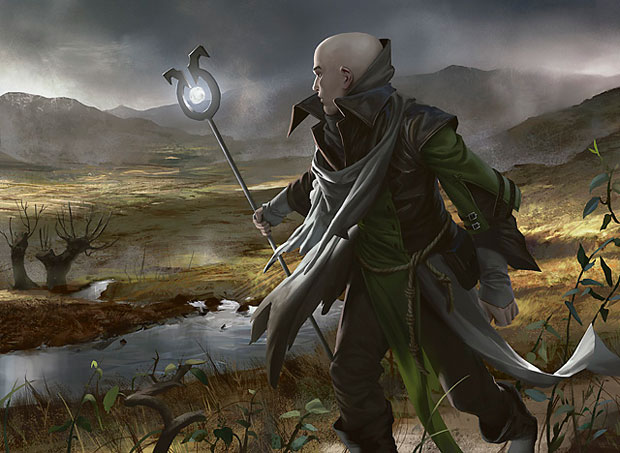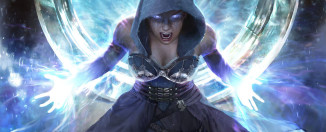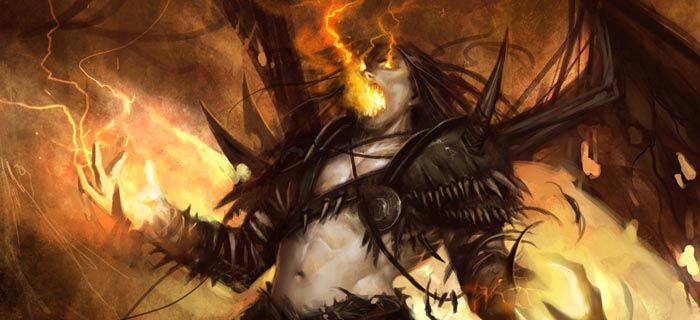Going From Duels 2013 to Paper Magic [Pt. 2]
Recently I wrote an introductory guide for Duels of the Planeswalkers players curious about getting into paper Magic, so if you missed that, head here first, as I’ll be referencing a lot of information in from it here.
In this second part, I’ll be going over the key differences and similarities between the two mediums, so you can be relatively prepared when you head down to the shop for your first games.
Deckbuilding
For starters, you can customize your land base, which opens up many possibilities in itself. If you’re making a “weenie” deck, for example (meaning it’s filled with tons of cheap creatures), you can cut it back to maybe 16 lands versus the more common 20-24, which makes room for yet more creatures and enchantments and such; if it’s big, costly creatures and/or control you enjoy, you can put in perhaps 26 or more lands and/or mana accelerators like Borderland Ranger to feed your greed, and ensure you’ll (almost) always have the mana you need to drop your bombs.
Dual lands — and currently shocklands as well — are a prominent fixture in paper. Once upon a time, these wonderful, special lands let you tap for either of two colours of mana with no restrictions, making multicoloured decks more powerful than mono-coloured decks in almost all instances — no longer were you screwed because you didn’t pull that Swamp you needed in time (at least not usually). Realizing how freaking broken this was, Wizards began printing new ones, but with downsides: some deal damage to you when you tap them (pain lands) and some may or may not come into play tapped for a variety of reasons (like the now Standard shocklands, which let you choose between 2 damage to your face and them coming into play tapped). In any case, they’re still critical to multi-coloured decks, so if you ever decide to go this route, check into them. If you’re a budget player, you can go with the cheap as dirt Evolving Wilds and/or the Guildgates (like Rakdos Guildgate), which help get you the mana you need, but don’t offer the “either/or” service or the speed of dual lands and shocklands.
Last but not least is sideboarding. While not essential, it’s strongly recommended if you have any real drive to place top 3 at Friday Night Magic, and subsequently win some free boosters. Simply put, your sideboard is 15 cards that accompany your main deck but are never present in it in the first round. Rather, after the first round with a given opponent, you’re allowed to swap out any of the 15 cards for cards in the deck, as the situation calls for. So if you’re playing burn, your opponent is playing counter, and you had a lot of trouble getting your damage in game 1, you can swap in some counter of your own, or perhaps some creatures or enchantments or whatever will help you get your hits in. Once your game with a given opponent is over, you must restore your deck to its original state. Sideboard cards generally compensate for any potential weaknesses in the main deck, though some sport “transformative” sideboards, which can change the main deck drastically to mess with the opponent.
Mechanics
The mana pool is another big one. Missing entirely from Duels, this wonderful mechanic lets you use creatures and spells in addition to land to let you jack up your usable mana for one phase only (by phase I generally mean your first and second main phases, which take place before and after any combat). Not all decks use it, but the ones that do are often a lot of fun. In Standard right now (remember, that’s the format comprising the most recent sets of cards), a couple key cards that utilize the mana pool include Infernal Plunge (mainly for Blue/Red Izzet decks), and Avacyn’s Pilgrim (mainly for Green/White Selesnya decks). Using Infernal Plunge as an example, say you have Guttersnipe and Goblin Arsonist on the field — you cast Plunge and sac Arsonist, dealing 3 damage to your opponent (2 from Guttersnipe and 1 from Arsonist), then drop Brimstone Volley for 5 (because a creature — Arsonist — died this turn). So you see, 8 damage to the face is why both the mana pool and combo burn is fun.
Manual mana tapping, is newly present in Duels 2013, and is especially useful in the expansion. If you’re not familiar with it, it’s a pretty simple concept: there are times in a multi-coloured deck where you’ll want to tap specific lands to leave others free to cast specific spells. For example, you have two Plains and one Mountain; you want to cast two spells, one of which costs 1 colourless and one White, while the other costs one Red. In Duels, this has traditionally meant you’d sometimes be at the whim of the computer which might tap the Mountain in order to play the 1 colourless for the White spell, preventing you from casting that second spell you really needed that turn. In paper Magic, you can tap whatever the heck you please.
Mulliganing (or “mulling”) in paper Magic is slightly different at competitive events, which is to say you don’t get a free one as in Duels. No land hand? Too bad, you mull down to six, then five, and so on. As such, make sure your deck is as consistent as possible, and has enough of a land base to get you what you need most of the time the first go-round — test on sites like TappedOut.net before you build the deck, and after that, play solo to test your draws until it’s tuned to perfection. Of course, if you’re just playing casually with friends, you can set whatever rules for mulling you like (I recommend one free mull, but some prefer at least a few).
Whatever you do, don’t be the guy that I saw about a month ago who threw all his cards down on the table and shifted them around for “optimal randomization”. Good shuffling is important to making sure you don’t have to mull much, so make sure you pick a method that you’re both comfortable and confident with. Everyone has their preferred method and you’ll see all kinds when you go to FNM, but if you’re in doubt about what to go with, just start with the standard technique of dropping about 10 cards from the back into each other part of the deck, and repeat about 10 times. Also important: pile shuffle when you first build the deck or do significant work to it, and by this I mean divide your deck into six piles before reforming and shuffling it the usual way — this is to help distribute the cards which are always clumped together in groups at this stage.
Cutting is what comes after shuffling. Once you’re finished, “present” your deck to your opponent, at which point he’ll either cut it (take cards off the top and put them on the bottom), or decline to cut by tapping your deck with his knuckle or just stating as such. Naturally, this is to prevent any sort of cheating. Many opponents don’t cut as a sign of trust or just indifference (FNM is a “casual competitive” event, so it’s not required and often not taken too seriously, except by our friend Francis below), so it’s entirely up to you what you’d like to do.
Supplies
Dice, sleeves, and deck boxes — don’t leave home without ’em! Or in your case, buy them as soon as you get to the shop and have your deck ready.
The 20-sided spindown die is the usual method for keep tracking of your life total, so grab at least one of those (should be less than a dollar), and pick up one of those cube-shaped dice containers with the tiny dice if you plan on playing with tokens (using one official token per creature type and dice to represent how many of that creature there are) — these cost about $8. On that note, if you need tokens, just check the binders or ask around — they’re never hard to come by.
As for sleeves, these not only protect your cards, but make shuffling a hell of a lot easier and more efficient. I strongly recommend Ultra Pro sleeves over anything else, as they have a sleek feel and look to them and are generally far more durable than anything else out there — they should run you about $8. You may want to pick up an extra set for drafts, too.
Deck boxes ($3) should be obvious: they generally make transporting your deck easy, and typically come with a divider to separate your sideboard from your mainboard, too.
Those are the essential goods you’ll need, but you can pick up other items like playmats (which make play more pleasant and also give you room if your LGS is crowded), bags, trade binders and sleeves, and a bunch of other stuff I’m probably forgetting.
Cost
Unlike Duels, paper Magic will cost you more, but I assure you you’ll get a hell of a lot more out of it. Budget decks can actually go as low as about $5-10, but you generally don’t want to go below $50, and in some cases dumping $300 or more into a deck can be the best thing for it. Don’t let that make you think you can throw money at a deck and 4-0 every FNM, though — any good $50 budget deck will almost definitely mop the floor with a purely money deck that lacks any synergy.
Conclusion
So, hopefully this helps any of you curious but nervous Duels players out there get into the joy that is paper Magic — I was you not long ago, and let me tell you, Magic is a wide, wonderful world when you step outside your gaming room.

![Going From Duels 2013 to Paper Magic [Pt. 2]](https://www.toptiertactics.com/wp-content/uploads/2012/10/Infernal-Plunge.jpg)






Please tell them of the pandora’s box known as “Mana Ratios”. I have been playing magic for over 15 years, I own cards from Alpha and Beta (not bragging just saying I know the game well). The hardest part of learning to play, besides Split Second (wait you mean i can’t in response you?!?!), was getting my mana production to match my deck’s needs
Ah yes, forgot that one. For that, you should use 24 land as a baseline, and increase or decrease depending on you mana curve and amount of mana dorks you have. If you have eight mana dorks (e.g. 4x Arbor Elf and 4x Avacyn’s Pilgrim), remove land for half the amount of dorks you have, so four, giving you 20 lands; if your curve ends at 5 converted cost (cc), start with 22 or 20 lands — combine formulas as needed. Playtest a lot and find what works best.
As a tip, if you put your deck on Tappedout.net you can calculate draw odds for land.
Don’t forget the total number of colored symbols on each card. For instance if you have “Wrath of Gods” and other multi white symbol cards, as opposed to other colors, in your deck, you should probably tilt your mana production more twoards white. Once again your article has information that I wish I didn’t have to learn the hard way, cause my freinds are dicks and would rather see me struggle than help me improve.